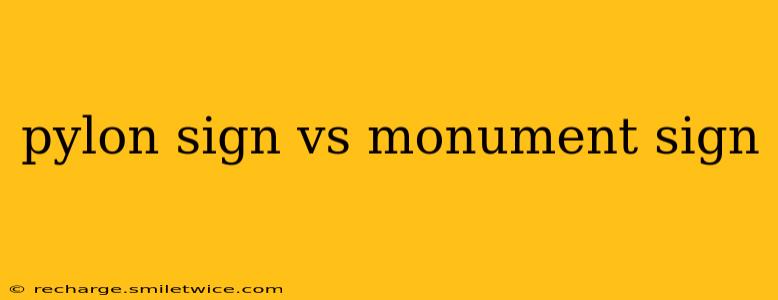Choosing the right signage for your business can significantly impact its visibility and brand recognition. Two popular choices often considered are pylon signs and monument signs. While both serve the purpose of attracting attention, they differ significantly in design, placement, and overall impact. This comprehensive guide will delve into the key differences between pylon signs and monument signs, helping you make an informed decision for your business needs.
What is a Pylon Sign?
Pylon signs are freestanding signs typically featuring two or more posts supporting a large, often illuminated, sign structure. They are frequently used for identifying locations with multiple tenants or businesses within a shopping center, complex, or other shared spaces. Their height and prominent placement ensure high visibility from a distance, making them ideal for attracting drivers and passersby.
Key Characteristics of Pylon Signs:
- Height: Generally taller than monument signs, often exceeding 20 feet.
- Structure: Supported by multiple posts or pylons.
- Placement: Commonly found at entrances to commercial properties or along roadways.
- Illumination: Frequently illuminated for increased nighttime visibility.
- Design: Can accommodate multiple business logos and messages.
What is a Monument Sign?
Monument signs are low-profile, freestanding signs characterized by their solid, substantial base. They're often built from materials like brick, stone, or concrete, giving them a more permanent and sophisticated look compared to pylon signs. Monument signs are ideal for projecting an image of permanence, stability, and professionalism.
Key Characteristics of Monument Signs:
- Height: Typically shorter than pylon signs, rarely exceeding 8 feet.
- Structure: Built with a solid base and often incorporates landscaping elements.
- Placement: Usually positioned closer to the building they identify, often at the entrance or property line.
- Illumination: Can be illuminated, but often rely on their inherent design and material for visibility.
- Design: Often features a more refined and understated design compared to pylon signs.
Pylon Sign vs. Monument Sign: A Detailed Comparison
| Feature | Pylon Sign | Monument Sign |
|---|---|---|
| Height | Tall (often > 20 feet) | Short (typically < 8 feet) |
| Structure | Multiple posts, often steel | Solid base, often brick, stone, or concrete |
| Placement | Typically further from the building | Closer to the building |
| Visibility | Excellent from a distance | Good, especially from closer proximity |
| Cost | Generally more expensive | Can be more or less expensive depending on materials |
| Best Suited For | Large complexes, multiple businesses, high traffic areas | Single businesses, professional offices, emphasis on sophistication |
| Illumination | Usually illuminated | Can be illuminated, but not always necessary |
What Type of Sign is Right for My Business?
The best type of sign for your business depends on several factors, including:
- Budget: Pylon signs tend to be more expensive due to their size and complexity.
- Location: High-traffic areas may benefit more from the increased visibility of a pylon sign.
- Branding: Monument signs may be more suitable for businesses wanting to project a sense of sophistication and permanence.
- Local Regulations: Zoning ordinances and building codes can restrict sign height and placement.
How Much Does a Pylon Sign Cost?
The cost of a pylon sign varies considerably based on size, materials, design complexity, and installation location. Expect to invest a significant amount, generally ranging from several thousand to tens of thousands of dollars.
How Much Does a Monument Sign Cost?
Similar to pylon signs, the cost of a monument sign is highly variable. Material choice (e.g., brick vs. granite), size, design intricacies, and installation all influence the final price. Costs can range from a few hundred to several thousand dollars.
What Permits Do I Need for a Pylon or Monument Sign?
Before installing any type of freestanding sign, it's crucial to check with your local authorities regarding permits and regulations. Requirements vary widely depending on location, sign size, and placement. Ignoring these requirements can lead to fines or even the removal of your sign.
By carefully considering these factors and the differences between pylon and monument signs, you can make an informed decision that effectively promotes your business and strengthens your brand identity. Remember to consult with a professional signage company for personalized advice and assistance in the design and installation process.
